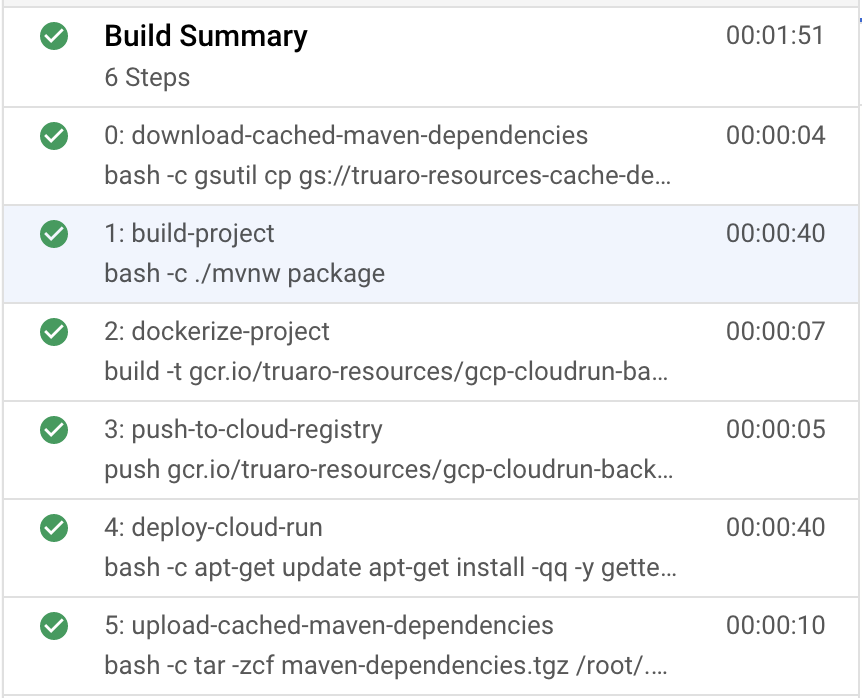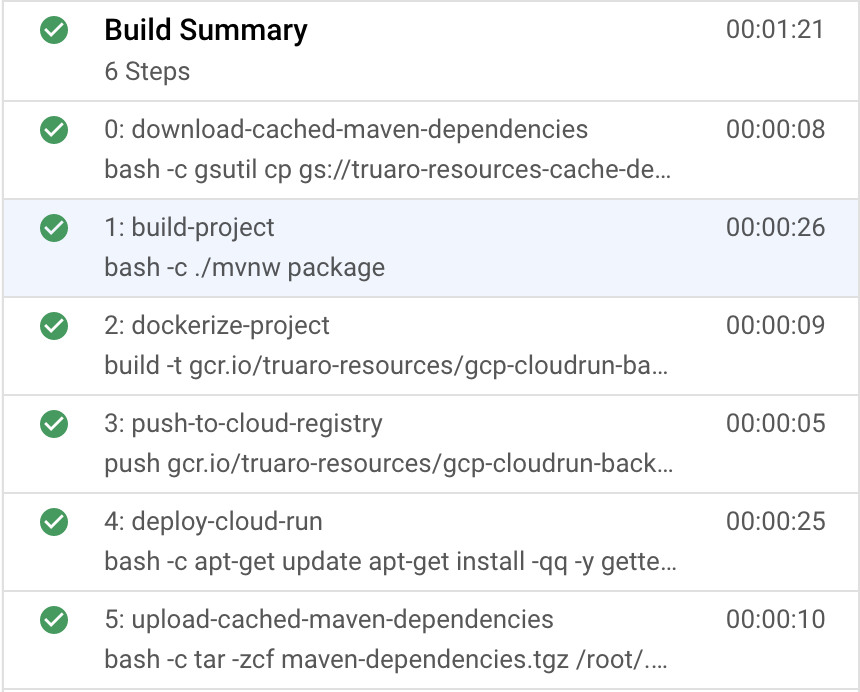Improving Cloud Build pipeline with dependencies cache on Cloud Storage

In this article we focus on optimizing a Cloud Build pipeline by reducing the build time by adding a dependency cache stored on a Cloud Storage bucket.
Introduction
Building a Continuous Deployment pipeline is amazing as you collect feedback on a daily basis. At first, the pipeline is quite quick and deploying applications is easy. But as your application is growing, you might have faced more and more latency... This article is here to show you how you can reduce the build time by adding dependencies cache on Cloud Storage.
For this focus, I'll simply use this cloudbuild.yaml file, watch the current deployment time, and explore how we improved it using Google Storage cache.
steps:
- id: 'build-project'
name: adoptopenjdk/openjdk11:jdk-11.0.8_10-slim
dir: gcpcloudrunback
entrypoint: bash
args:
- '-c'
- |
./mvnw package
- id: 'dockerize-project'
name: gcr.io/cloud-builders/docker
dir: gcpcloudrunback
args: [ 'build',
'-t', 'gcr.io/$PROJECT_ID/gcp-cloudrun-back:$SHORT_SHA',
'-t', 'gcr.io/$PROJECT_ID/gcp-cloudrun-back:latest',
'.' ]
- id: 'push-to-cloud-registry'
name: gcr.io/cloud-builders/docker
args: [ 'push', 'gcr.io/$PROJECT_ID/gcp-cloudrun-back:$SHORT_SHA' ]
- id: 'deploy-cloud-run'
name: gcr.io/cloud-builders/gcloud
dir: gcpcloudrunback
entrypoint: bash
args:
- '-c'
- |
apt-get update
apt-get install -qq -y gettext
export PROJECT_ID=$PROJECT_ID
export IMAGE_VERSION=$SHORT_SHA
export SCALING_INSTANCE_COUNT=${_SCALING_INSTANCE_COUNT}
envsubst < gcp-cloudrun-back.yaml > gcp-cloudrun-back_with_env.yaml
gcloud beta run services replace gcp-cloudrun-back_with_env.yaml \
--platform=managed --region=europe-west1
gcloud run services add-iam-policy-binding gcp-cloudrun-back \
--platform=managed --region=europe-west1 \
--member="allUsers" --role="roles/run.invoker"
images:
- 'gcr.io/$PROJECT_ID/gcp-cloudrun-back:$SHORT_SHA'
- 'gcr.io/$PROJECT_ID/gcp-cloudrun-back:latest'
Here is the associated Dockerfile
# Use AdoptOpenJDK for base image.
FROM adoptopenjdk/openjdk11:jre-11.0.8_10-alpine
# Copy the jar to the production image from the previous step
COPY target/*.jar /app.jar
# Run the web service on container startup.
CMD ["java", "-jar", "/app.jar"]
- In this pipeline, we build our application using the maven wrapper from our project. Besides, we use a simple Dockerfile, not a multi-staged one.
- Also note you need to grant Cloud Build service account the
Cloud RunandService Accountsroles.
Reducing the build time with cache
Currently, when deploying this pipeline (based on this Github project), it takes my build 1 minute and 45 seconds on average to complete. Let's first understand this build time, to see what can be improved. 
- The longest step is the one where the dependencies need to be installed
build-project, where we see all the dependencies are downloaded. If you think that those dependencies will not change so often, it clearly needs some optimization to avoid unnecessary resources to be used.
Add maven cache
Reading Google Cloud build optimizations documentation, we can manually add Google Storage cache to reduce build time.
Note that some Cloud Build competitors offer easily managed caching solutions... such a shame Cloud Build is not and we have to do everything manually.
Create a storage bucket
We will store our dependencies cache into a specific bucket. Let's create one:
gsutil mb gs://${PROJECT_ID}-cache-dependencies
> Creating gs://${PROJECT_ID}-cache-dependencies/...
Replace
${PROJECT_ID}with your actual project Id. Cloud storage needs a unique name among all the buckets in the system. By prefixing your bucket with your project Id, there is a low chance to collide with another bucket name.
Add steps to fetch and save the cache
To fetch and save the cache downloaded by Maven:
- We will use the volumes features of Cloud Build. By default, Cloud Build persists the folder
/workspaceacross your build steps. We can specify other volumes to be persisted. - Cloud Build does not offer yet an easy way to cache dependencies for any usage across different builds.
- It does not offer also the possibility for a step to fail silently without stopping the pipeline.
Knowing this, here is what the final cloudbuild.yaml with dependencies cache looks like:
steps:
- id: 'download-cached-maven-dependencies'
name: gcr.io/cloud-builders/gsutil
entrypoint: bash
volumes:
- name: 'maven-repository'
path: '/root/.m2'
args:
- '-c'
- |
gsutil cp gs://${PROJECT_ID}-cache-dependencies/cache/maven-dependencies.tgz maven-dependencies.tgz || exit 0
tar -zxf maven-dependencies.tgz --directory / || exit 0
- id: 'build-project'
name: adoptopenjdk/openjdk11:jdk-11.0.8_10
dir: mavencachecloudbuild/gcpcloudrunback
entrypoint: bash
volumes:
- name: 'maven-repository'
path: '/root/.m2'
args:
- '-c'
- |
./mvnw package
- id: 'dockerize-project'
name: gcr.io/cloud-builders/docker
dir: mavencachecloudbuild/gcpcloudrunback
args: [ 'build',
'-t', 'gcr.io/$PROJECT_ID/gcp-cloudrun-back:$SHORT_SHA',
'-t', 'gcr.io/$PROJECT_ID/gcp-cloudrun-back:latest',
'.' ]
- id: 'push-to-cloud-registry'
name: gcr.io/cloud-builders/docker
args: [ 'push', 'gcr.io/$PROJECT_ID/gcp-cloudrun-back:$SHORT_SHA' ]
- id: 'deploy-cloud-run'
name: gcr.io/cloud-builders/gcloud
dir: mavencachecloudbuild/gcpcloudrunback
entrypoint: bash
args:
- '-c'
- |
apt-get update
apt-get install -qq -y gettext
export PROJECT_ID=$PROJECT_ID
export IMAGE_VERSION=$SHORT_SHA
export SCALING_INSTANCE_COUNT=${_SCALING_INSTANCE_COUNT}
envsubst < gcp-cloudrun-back.yaml > gcp-cloudrun-back_with_env.yaml
gcloud beta run services replace gcp-cloudrun-back_with_env.yaml \
--platform=managed --region=europe-west1
gcloud run services add-iam-policy-binding gcp-cloudrun-back \
--platform=managed --region=europe-west1 \
--member="allUsers" --role="roles/run.invoker"
- id: 'upload-cached-maven-dependencies'
waitFor: [ 'build-project']
name: gcr.io/cloud-builders/gsutil
entrypoint: bash
volumes:
- name: 'maven-repository'
path: '/root/.m2'
args:
- '-c'
- |
tar -zcf maven-dependencies.tgz /root/.m2
gsutil cp maven-dependencies.tgz gs://${PROJECT_ID}-cache-dependencies/cache/maven-dependencies.tgz
images:
- 'gcr.io/$PROJECT_ID/gcp-cloudrun-back:$SHORT_SHA'
- 'gcr.io/$PROJECT_ID/gcp-cloudrun-back:latest'
Let's review the important part.
- The first is about downloading the maven from the Cloud Storage bucket.
- id: 'download-cached-maven-dependencies'
name: gcr.io/cloud-builders/gsutil
entrypoint: bash
volumes:
- name: 'maven-repository'
path: '/root/.m2'
args:
- '-c'
- |
gsutil cp gs://${PROJECT_ID}-cache-dependencies/cache/maven-dependencies.tgz maven-dependencies.tgz || exit 0
tar -zxf maven-dependencies.tgz --directory / || exit 0
name: gcr.io/cloud-builders/gsutil: use a provided Google image withgsutilto manage buckets.volumes:: persist a volume across build steps. With maven, the default volume is/${USER_HOME}/.m2, which is/root/.m2in our different images.gsutil cp && tar -xzf: downloading the files from the bucket (in.tgzto reduce dependencies size).|| exit 0: As mentioned earlier, there is no easy way to ignore steps on error. Just addexit 0to make sure if the folder does not exist on the bucket your build does not fail. I know it is not a perfect solution, but the step is small enough not to damage the entire pipeline. Besides, if you don’t have cache, you can still build the application.
- Use the volume persisted by the previous steps to enhance the
./mvnwcommand
- id: 'build-project'
name: adoptopenjdk/openjdk11:jdk-11.0.8_10-slim
dir: mavencachecloudbuild/gcpcloudrunback
entrypoint: bash
volumes:
- name: 'maven-repository'
path: '/root/.m2'
args:
- '-c'
- |
./mvnw package
Thanks to the shared volume, when the step will execute
./mvnw packageit will rely on the dependencies provided by Cloud Storage.
- Upload the dependencies. Very useful if you changed your
pom.xmland you need to update the cache with the new dependencies
- id: 'upload-cached-maven-dependencies'
waitFor: [ 'build-project']
name: gcr.io/cloud-builders/gsutil
entrypoint: bash
volumes:
- name: 'maven-repository'
path: '/root/.m2'
args:
- '-c'
- |
tar -zcf maven-dependencies.tgz /root/.m2
gsutil cp maven-dependencies.tgz gs://${PROJECT_ID}-cache-dependencies/cache/maven-dependencies.tgz
- In this step, we expect it not to fail, so we don't use
exit 0.- We reuse the volume created by
download-cached-maven-dependenciesand potentially modified bybuild-project.- We use the
waitForto start this step right after thebuild-project, as this volume will no longer be modified later.
Results
The first build will be slightly longer, as you added 2 steps and there is no cached yet. But the next ones will be faster !
Here is the result of the first build, before the cache was created.
Here is the result of the second build, after the cache was created.
For now, we save couple of seconds (30 seconds), not worth it you might say. But keep in mind your build will get bigger and bigger, and if you do not optimize it, it will take minutes before completion. Today, we simply deploy one single Cloud Run service, but we can deploy 2 or 3, with Cloud Functions as well. If you download maven dependencies each time, you will waste a lot of time and resources. So keep that in mind.
Bonus: the same for a frontend project with yarn
Here is the cloudbuild.yaml file to also save yarn dependencies.
steps:
- id: 'download-cached-yarn-dependencies'
name: gcr.io/cloud-builders/gsutil
dir: gcpfirebasefront
entrypoint: bash
args:
- '-c'
- |
gsutil cp gs://${PROJECT_ID}-cache-dependencies/cache/yarn-dependencies.tgz yarn-dependencies.tgz || exit 0
tar -zxf yarn-dependencies.tgz || exit 0
- id: 'install-yarn'
name: node
entrypoint: yarn
dir: gcpfirebasefront
args: ['install', '--silent']
- id: 'build-front'
name: node
entrypoint: yarn
dir: gcpfirebasefront
args: [ 'build' ]
- id: 'deploy-firebase'
name: gcr.io/$PROJECT_ID/firebase
dir: gcpfirebasefront
args: [ 'deploy', '--project=$PROJECT_ID', '--only', 'hosting' ]
- id: 'upload-cached-yarn-dependencies'
waitFor: ['build-front']
name: gcr.io/cloud-builders/gsutil
entrypoint: bash
dir: cloudcmr-front
args:
- '-c'
- |
tar -zcf yarn-dependencies.tgz ./node_modules
gsutil cp yarn-dependencies.tgz gs://${PROJECT_ID}-cache-dependencies/cache/yarn-dependencies.tgz
Note for yarn the dependencies are located under /workspace folder hierarchies. Therefore, there is no need to add a custom volume to be persisted by Cloud Build
Summary
In this article focuses on optimizing Cloud Build with Maven and Yarn build steps, we covered:
- Common issues when not caching dependencies, by wasting resources and times
- Creation a bucket using
gsutilto store dependencies - Ignore steps in error, which is not provided out-of-the-box by Cloud Build at this time
- Persistence of other folders across a build
- Downloading and fetching files from a Cloud Storage bucket
Please note using Cloud Storage as cache storage will incur small fees as you pay for the GigaBytes stored. But don't worry, the cached maven folder is 61MB, which is free for your usage.
To go further
If you feel like it, you can improve some parts of the build by:
- Instead of downloading a file from a bucket, why not build an image containing all the dependencies you need ?
- Use a hash to make upload the dependencies only if they changed since last build
- You can also store docker image in a Bucket, which make the build even faster (using Google Jib)
- Improve the build avoiding hiding the errors when downloading the files from the cache folder
- Configure your bucket to delete files older than 2 weeks, in order to save some money for a cache that is no longer used.
